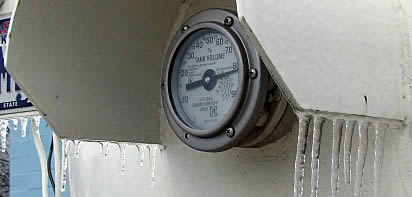Propane Volume and Temperature Correction

The liquid propane volume in any LP Gas container is directly related to its temperature. In fact, the volume of any liquid in any container is directly related to its temperature. Propane volume rises as temperature rises and falls as temperature falls. Being temperature dependent, propane becomes more dense as temperature falls and expands as temperature increases. This is extremely important to remember when understanding propane temperature and volume and the relationship between the two. Propane is stored and delivered as a liquid. In comparison to other liquids regarding temperature and volume, it is no different. The volume of any liquid will rise and fall dependent upon temperature.
Propane Volume Basics
To understand what's going on with regard to differing tank gauge readings in extreme temperatures (hot or cold), we need to first explain basic principles that affect the liquid propane volume. The following example assumes a 250 gallon propane tank has 100 gallons of propane at 60°F. The industry standard 60°F is universally recognized as the base reference point for liquid propane volume correction.
- A properly functioning float gauge will read 40%
- 100 gallons of propane weighs 424 pounds (4.24 lbs. per gallon)
If there is a significant temperature drop (over 20°F) the gauge will indicate that there is less propane in the tank. Assuming the gauge dial sits between 35% and 40% following the temperature drop, there are still 424 pounds of propane in the tank. Although the propane volume has decreased, the amount of propane has not decreased, it has simply become more compact (dense). The amount of usable energy has not decreased. If the temperature were to rise by the same respective amount, the gauge would indicate a higher volume of propane but there would still be 424 pounds of propane in the tank. As temperatures fall, liquids become more dense and compact. As temperatures rise, liquids become less dense and expand. Propane is a liquid and is subject to the same rules of mother nature.
Cold Temperature Propane Deliveries
Propane users can become quite confused during periods of cold weather following a gas delivery because their propane tank gauge may read less than what they expect it to read. Using the information from above, a 100 gallon delivery on a cold day (far below 60°F) may indicate less than 100 gallons delivered just by looking at the gauge. If the temperature were to rise to 60°F, a properly functioning float gauge would rise to 40%, assuming the tank was empty at the time of delivery. Cold weather often brings confusion and frustration for propane customers concerning perceived propane volume and the actual amount of propane delivered but the reality is this; When a propane delivery is made during cold temperatures, the tank gauge will indicate less propane delivered based on the beginning and ending gauge readings but the actual amount of propane delivered, according to a properly calibrated truck meter is what was truly pumped into the tank during the delivery.
We could explore gauge readings and propane volume correction in hot weather and high temperatures but nobody seems to be concerned when their tank gauge indicates that more propane was delivered than actually was. However, we will briefly explain below the propane truck's built in volume correction device, called a temperature compensator.
Propane Truck Volume Correction - Temperature Compensation
If temperature compensation was not taken into account, propane companies would be either getting more propane than they paid for less, depending on the temperature. Considering volumes in excess of 10,000 gallons are being delivered into a bulk storage plant, it's assured that propane companies certify volume correction factors are in place. The same is true on the consumer side but state and federal governments regulate measurement that is protective of the consumer.
Propane delivery trucks all have meters that measure the amount of propane pumped into consumer tanks. These meters include a volume correction device known as an automatic temperature compensator. The temperature compensator takes into account the temperature of the liquid propane running through the meter and automatically adjusts to correctly deliver the amount of propane that the consumer ordered. By law, these devices are required to be re-calibrated and are adjusted based on the temperature of the liquid at the time of calibration. When a delivery of propane is made to your home or business, know that the amount you paid for is the amount you are actually getting.
